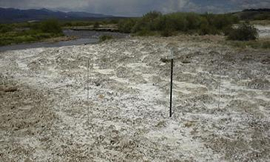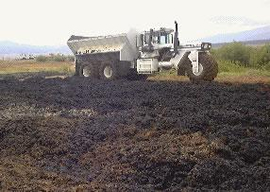Green Remediation Focus
Upper Arkansas River
Leadville, Colorado
Former Superfund
Cleanup Objectives: Address heavy metals contamination, including cadmium, copper, lead, manganese, and zinc, caused by past mining activities along an 11-mile stretch of the Upper Arkansas River.
Green Remediation Strategy: The focus of the strategy included treating soil by applying 100 dry tons (pellets) of biosolids to each of 20 target acres along an 11-mile stretch of the Upper Arkansas River:
- Mixed biosolids with lime to reduce soil acidity, supporting increased plant viability and metal insolubility.
- Seeded native plants and quick-growing ryegrass.
- Added compost and wood material as additional plant nutrients.
- Added wood chips to reduce nitrogen (nutrient) leaching.
- Covered amended soil with native hay to promote plant growth and seeding.
Site Assessment: No site assessment work needed, removal only site.
Results:
Land & Ecosystems Protection
- Revegetated denunded acreages.
- Reduced concentrations/bioavailability of zinc and other metals through bioremediation, phytoremediation processes, and solubility reduction.
- Neutralized soil to levels supporting healthier ecosystems.
- Reduced soil erosion, river channel degradation, and property loss.
- Re-established communities of native plants, such as white yarrow and tufted hairgrass.
Property End Use: Agriculture and recreation
Site has been archived.
Update: July 2024













